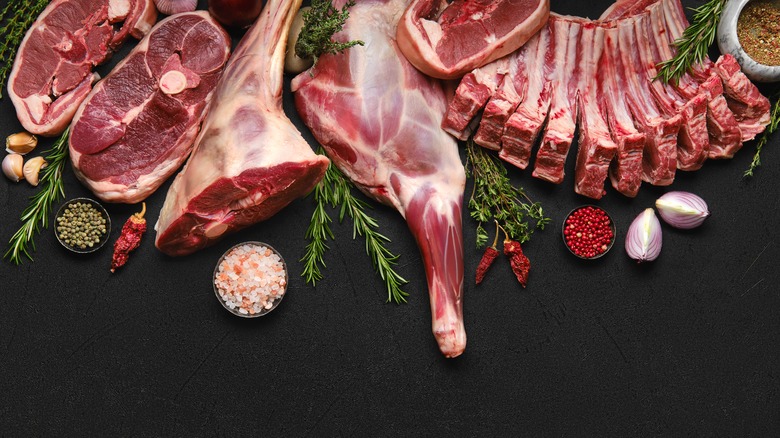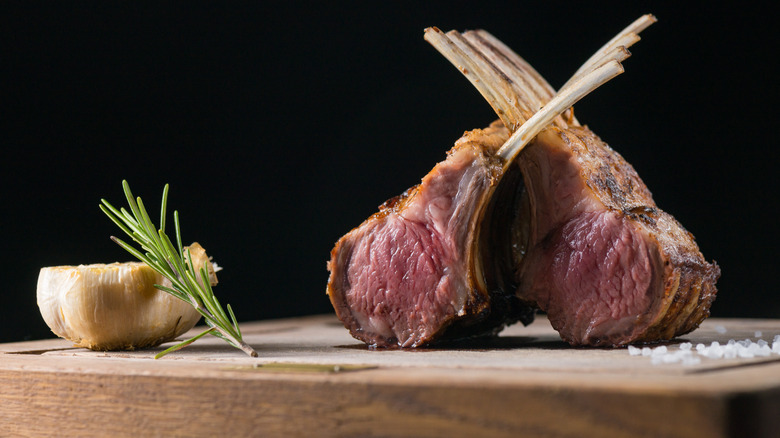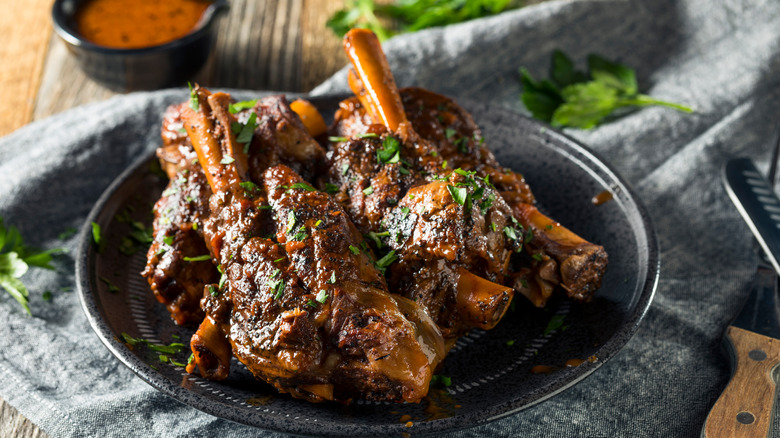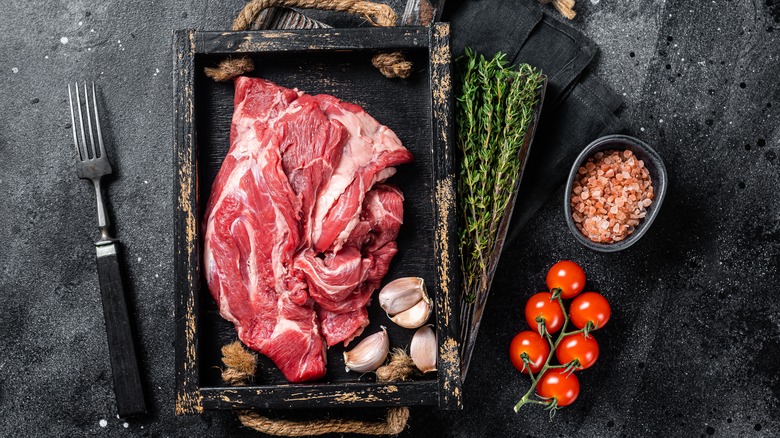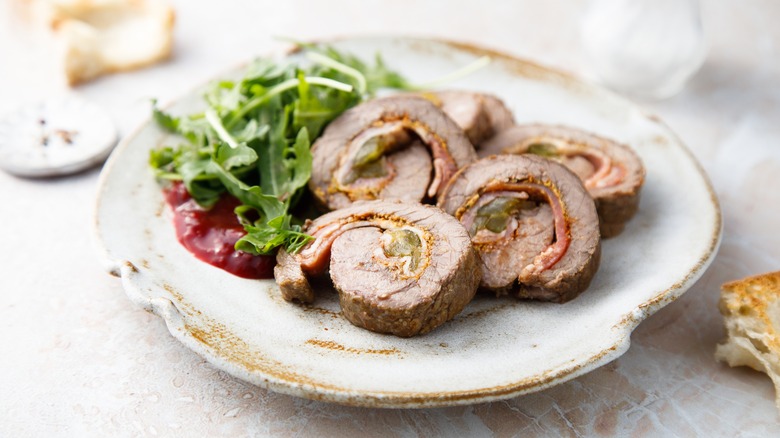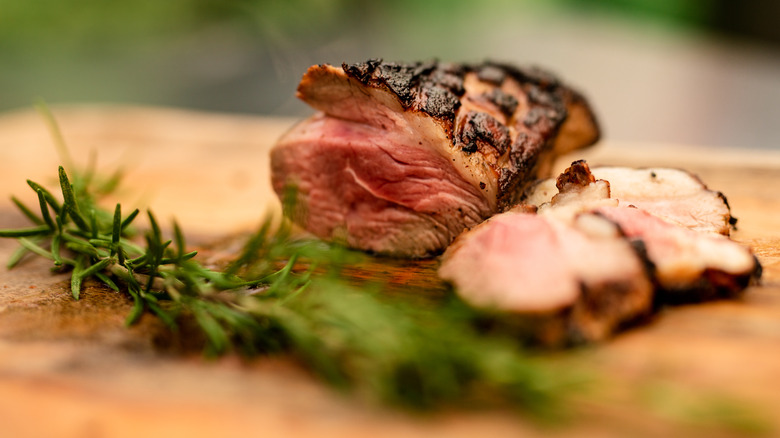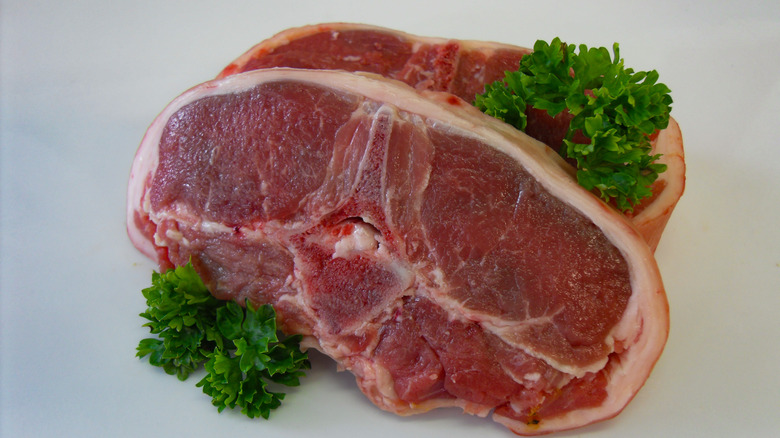The 16 Absolute Best Cuts Of Lamb To Roast
Lamb is one of our favorite proteins to cook with, but for some reason, it's not a household staple like chicken, pork, or beef. Americans have no problem serving lamb as a holiday centerpiece, but most are less likely to include lamb in their weekly meal plan. The US Department of Agriculture Economic Research Service reports that veal and lamb consumption is down in the United States, decreasing from 2.7 pounds per capita in 1970 to less than a pound by 2017, while chicken and turkey have shown notable gains in the same time period (up to 52.3 pounds per capita).
So why is that? It could have something to do with price — a chicken is less expensive than a rack of lamb — but it could also be that lamb seems intimidating to cook and hard to pull off. With so many different cuts, how does one know which cuts are best in the oven and which are better on the stovetop or smoker?
While we love cooking lamb on the grill, we've found that it's sometimes easier to roast lamb in the oven. There are several types of lamb to choose from for roasting, and Chef George Duran (host of Food Network's "Ham on the Street") says it's worth trying out different cuts, "You may discover you're a fan of an unexpected cut." So we looked at all the possible cuts of lamb you could roast in the oven and came up with a comprehensive list of suggestions.
Rack of lamb and crown roast
Chef George Duran says rack of lamb is his, "absolute favorite cut of lamb to cook, mainly because it's so easy to make and it's so much fun to eat." He admits that he eats it with his hands, even when he's at the finest restaurants! This cut of meat is naturally tender, so it doesn't require very much time in the oven to turn out perfect: One rack of lamb takes about 25 minutes in a 450 F oven for a medium-rare finish. You don't need any fancy marinades to break down a rack of lamb's muscle fibers, either. A simple lamb seasoning of oil, chopped garlic, and fresh herbs like rosemary will do the trick nicely.
For a more impressive display, turn a rack of lamb into a crown roast. This roast gets its name because it looks like a crown when two racks are tied together. If you don't have any twine, you can use Alton Brown's trick of roasting the crown roast in a bundt pan.
Leg of lamb
Peter DeLuca took over Vincent's Meat Market when his father, Vincent DeLuca, passed away in 1979. He's been butchering beef, poultry, pork, and lamb for a long time, so we trust him when he says a leg of lamb roast is one of the best cuts of lamb for the oven.
You have two options when it comes to roasting a leg of lamb: Go bone-in, or pick up a boneless roast. A bone-in leg roast takes longer to cook, but DeLuca prefers it because "the bones make the meat very flavorful." The collagen and bone marrow from the bone get released into the meat, creating a much more flavorful eating experience. Of course, a bone-in roast has to be carved around the bone, and while the process is not difficult, it can feel intimidating for many home cooks. The easiest solution is to opt for a boneless roast instead. A butcher can remove the femur and shank bones from the roast, trussing it up into a neat package that will roast evenly.
Either way, you'll want to start off roasting the leg in a high-temperature oven of 450 F. After about 20 minutes, you can turn down the temperature to 350 F until the roast reaches the desired temperature. All told, it should take less than two hours.
Lamb shoulder roast
A shoulder roast is less common than a leg of lamb or rack of lamb, but it's absolutely worth seeking out. Like the leg, the shoulder is a working muscle, so it needs to be cooked for several hours to break down all the connective tissue (via We Are Chefs). It's also beneficial to slow-cook lamb shoulder and reduce the temperature — 325 F instead of 350 F — to let the connective tissue break down into gelatin that keeps the lamb juicy and moist.
If you want the shoulder roast to cook faster, Peter DeLuca recommends asking the butcher to, "Crack it or cut it into quarters. This allows the lamb to cook faster and more evenly." As an added bonus, these extra cuts allow you to season more of the meat, adding spice and flavoring throughout the roast.
Lamb Denver ribs or spare ribs
It's unlikely you'll find lamb Denver ribs (also called spare ribs) at the grocery store, so you'll want to ask around at your local butcher shop for this obscure lamb cut. When we asked Peter DeLuca if lesser-known cuts like this are worth seeking out, he responded, "Absolutely, because the bones make the meat very flavorful."
You might recognize spare ribs as one of the many types of ribs you can use to make barbecue pork ribs. According to White Oak Pastures, lamb ribs are leaner than pork ribs, but they can be cooked in a similar fashion: on the barbecue, being braised in moist heat, or cooked with dry heat (like an oven). When roasting spare ribs in the oven, you'll want to set the temperature to 250 F and cook them for several hours until the fat has rendered and the ribs are tender. If the butcher has not removed the silver skin (the translucent membrane that covers the back of the ribs), you'll want to cut it off before roasting.
Lamb shanks
Lamb shanks are one of the more underrated cuts of lamb. They come from the shins, and there are two hind shanks and two fore shanks per lamb. The meat can be exceptionally tough if the shanks are cooked at high temperatures, but the meat becomes super flavorful and falls off the bone when treated right. Chef George Duran says he's a big fan of lamb shanks. "It's such a treat when I see it at a butcher," he told us. "It's a full-flavored cut that's perfect for slow cooking or braising."
Our favorite lamb shank recipe starts by roasting lamb shanks in a 425 F oven for about 20 minutes to give them a nicely caramelized exterior. Then, we transfer them to a flavorful broth and reduce the oven to 325 F. Duran suggests adding flavorful curries, spices, or sauces, or using red wine in the braising liquid. The meat should be tender and ready to enjoy after about 90 minutes.
Lamb saddle or lamb loin roast
Lamb saddle gets its name because it looks a little bit like a, well, saddle. Sometimes called the lamb loin roast, the saddle contains two lamb loins and tenderloins (via Heavy Table). If it were sliced into steaks, you would recognize it as lamb loin chops or porterhouse chops. The butcher usually takes out the backbone to create a boneless roast, which allows you to stuff the interior and roll it to create a gorgeous centerpiece.
Before stuffing and trussing the saddle, score the fat in a criss-cross pattern (like you would when cooking duck breasts). This allows the fat to melt more easily, helping the exterior crisp up to a pleasant texture. Some people like to sear the exterior of the lamb saddle on the stovetop before transferring it to a 250 F oven to finish. You could also follow a similar route to lamb shanks and cook the saddle in a high-temperature oven for 20 minutes to brown the fat before reducing the oven temperature.
Lamb sirloin roast
While the lamb loin (or saddle) comes from the middle of the lamb, the sirloin roast is closer to the hind leg (via The Cook's Thesaurus). It's often included in another cut of lamb we've discussed — the lamb leg — because it's the muscle that connects the loin to the leg. That means you may have to special order it if you want it as a stand-alone roast.
While you can cut this tender, lean meat into steaks or cubes for skewers, we love roasting the sirloin whole. It's a boneless cut that cooks very quickly compared to other roasts, and it has a pure, meaty flavor that's really hard to beat. After browning the sirloin roast on all sides on the stovetop, transfer it to a 400 F oven, where it should reach medium rare in about 30 minutes.
Ground lamb
Ground lamb isn't the first cut that comes to mind when it comes to roasting lamb, but there are plenty of times when it's a perfect choice. Ground lamb is used for making oven-roasted dishes such as lamb meatloaf, meatballs, kofta lamb kebabs, oven-baked burgers, or casseroles like shepherd's pie. Keep in mind that the USDA recommends different cooking temperatures for ground lamb; lamb roasts are suggested at a minimum internal temperature of 145 F, but ground lamb mixtures should be cooked to at least 160 F.
If you're having trouble shaping the ground lamb for meatballs or kebabs, Chef George Duran recommends putting it in the refrigerator. "Lamb retains its shape best when it's cold and not overworked," he says, so you may be difficult to mold it when it's warm. An hour or two in the refrigerator will go a long way to helping you form perfectly round meatballs.
Lamb neck or lamb scrag
While lamb neck is probably not the first cut you'd think of roasting, you might want to think again and reconsider it. Also known as lamb scrag, Peter DeLuca says this is one of the lesser-known cuts of lamb that's worth roasting, and Great British Chefs describes it as a solid option for folks budgeting because of its comparatively inexpensive price tag.
Like the lamb shank, this cut can turn out very tough if it's not cooked low and slow. While it is often sold as boneless filet meat, we recommend ordering a bone-in neck for roasting. You can ask the butcher to debone it for you if you're not comfortable with the knife work at home, but you want it in one whole piece. From there, it can be oven braised in a pot with some liquid.
Lamb breast
While we commonly think of chicken breasts (which come from the sternum section of the chicken), the lamb breast actually comes from the lamb's front belly section (via Simply Beef & Lamb). This cut is referred to as pork belly when it comes from a pig, and brisket when it comes from a cow, but lamb breast often contains rib bones. Unlike the other cuts on this list, lamb breast is decently fatty, so the meat turns out very juicy and moist when roasted low-and-slow in the oven. It's so tender, you might think you were eating a rack of lamb if you closed your eyes!
Simply Beef & Lamb recommends roasting the lamb breast at 300 F for just shy of two hours. To help the fat render, it's best to score the fat (like we did with the lamb saddle). You'll find that a significant amount of fat will be left behind after the breast has cooked, so you'll want to make sure to use a roasting pan or a casserole with tall sides to ensure the fat doesn't spill into the oven.
Lamb offal
The liver, kidneys, marrow, heart, brains, and tongue are certainly not the most popular cut of lamb (or any animal, for that matter), but they shouldn't be overlooked. For starters, Healthline reports that organ meats are highly nutritious and more nutrient-dense than muscle meat. Offal contains fat-soluble vitamins A, D, E, and K, is a rich source of B vitamins, and contains several beneficial minerals, like zinc, iron, and magnesium.
Beef + Lamb New Zealand goes on to say that these cuts can be delicious when you know how to cook them. Some offal is better suited for high-heat, quick-searing methods like sautéing or grilling, but several cuts can be roasted. Ask your butcher to cut lamb bones crosswise to access the marrow, which melts and becomes buttery after being roasted. Lamb's tongue is also fantastic when slow-roasted, lamb kidneys are an excellent addition to roasted casseroles, and lamb hearts can be stuffed and braised in the oven.
Saratoga roll
It helps to know your local butcher well to get your hands on this succulent roast. According to Cooks Info, the Saratoga roll is a boneless cut from the center area of the lamb between the shoulder blades. That gives it a good amount of marbling and a very tender characteristic.
Chef Alan Bergo told Shepherd Song Farm that he also knows this cut as the bone-in lamb forerib roast, and it's one of his favorite cuts. Unfortunately, he says it's also not that easy to find, but it's totally worth trying if you can locate it. When purchased bone-in, it must be deboned before being stuffed, rolled, and roasted for about 90 minutes. The roast doesn't have to be turned into a roll, though; Bergo goes on to say that the bone-in cut still turns out wonderful when slow-cooked.
Lamb rump or lamb chump
Sometimes called lamb rump and sometimes referred to as lamb chump, this cut comes from the lower back of the lamb. Jamie Oliver likes this cut of lamb because, when cooked properly, it turns out very tender and flavorful. He warns that the rump is very lean, though, and overcooking it will result in a dry, tough roast that's undesirable.
While the rump is often sold as chops, it's best to seek it out as a whole roast when cooking it in the oven. This boneless roast will cook perfectly in about 30 minutes in the oven, but thin chops would certainly overcook in an oven. If you end up with rump chops, they would benefit from high-heat cooking techniques like grilling or searing.
Lamb flank
According to Vincent's Meat Market, the lamb flank comes from the lamb's belly — like the breast — but it's located further back towards the hind legs. This roast usually contains several rib bones, but it does not contain a lot of fat, so it's lean and is prone to drying out when overcooked. One of the best reasons to choose the flank for roasting is because it cooks quickly and it's smaller than most lamb roasts, making it ideal when you're not cooking for a crowd. Recipes.co.nz says this "mini roast" will cook in about 20 minutes in a 375 F oven, making it a great choice for a weeknight dinner.
Chef George Duran suggests looking for grass-fed lamb for these types of roasts. "Personally, I look for New Zealand grass-fed lamb wherever I shop," he says. "New Zealand is home to some of the world's best-tasting grass-fed lamb — it's tender and naturally flavorful!"
Lamb Barnsley chops
The name of this lamb cut sounds as fancy as it is! The Barnsley chop is a cut that dates back to the 19th century. It's a bone-in, double-cut loin chop from the saddle, so it has a loin and tenderloin piece on each side of the backbone (via Welcome to Yorkshire). We would generally recommend grilling or pan-searing a loin chop, but this one happens to be so thick that it benefits from a roast in the oven.
It's best to start with a quick sear in a frying pan to promote the Maillard reaction, creating a beautiful brown crust on top of the chops. From there, you'll want to transfer the Barnsley chop to a baking sheet and finish it in a 375 F oven for about eight minutes. This will gently cook the chops through to a medium-rare temperature and result in perfectly tender meat that barely needs a knife to cut.
Lamb head
If you ever have the opportunity to roast a lamb head, you shouldn't shy away from the experience. We couldn't put it any better than Professor Reidar Mykletun of the Norwegian School of Hotel Management at the University of Stavanger when he talks about this traditional Norwegian dish (via EurekAlert!). He describes lamb head as being a "tempting experience for genuine lamb enthusiasts," but that it can be scary.
If you're ready to jump in and overcome the fear of the unknown, lamb head is a perfect cut for roasting. It only takes 40 minutes to an hour in a 400 F oven (via Cooking with Nonna), and it tastes fantastic with a side of potatoes or a rutabaga mash (as it would be served in traditional Norwegian style).
Still not sure about lamb head? Chef George Duran says a "sure-fire seasoning for lamb" is to make a rub "with chopped fresh herbs, like rosemary, and garlic with salt and pepper. Period. Keep it simple with these ingredients and your lamb will always taste amazing!"
